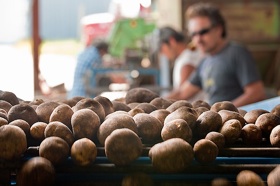New farm-to-school project aims to make it easier for public schools to serve Wisconsin vegetables
A lot of parents want their kids’ schools to serve more fresh and local food for lunch, and schools would like to oblige, but that’s no simple task.
It’s enough of a scramble to be ready to serve hundreds of hungry kids when the lunch bell rings without having to stop to take a lot of deliveries from local growers, let alone wash, peel and chop pound after pound of fresh fruits and vegetables.

A new project is working to get Wisconsin vegetables, like these state-grown potatoes, into more public-school cafeterias.
Photo: Bryce Richter
While some schools have been able to make this work, many simply don’t have the resources to do it. For them, one solution is to move the shopping and chopping a step up the supply chain, says Sara Tedeschi, who works on farm-to-school food programs at the University of Wisconsin–Madison Center for Integrated Agricultural Systems.
“Many school districts are supportive of farm-to-school and want to support Wisconsin producers, but they want the ease and flexibility and efficiency of being able to purchase local, ready-to-go products through the food distributors that they are already using,” she says.
Now, with funding from the U.S. Department of Agriculture, Tedeschi is teaming up with local vegetable growers, processors and distributors to make that happen. They plan to provide schools with affordable mixes of ready-to-roast Wisconsin-grown vegetables, and, in the process, open up new markets for the state’s vegetable growers.
“We’re going to work across the whole supply chain. We’ll work on procurement, we’ll work on processing and we’ll work with distributors that are already serving schools,” says Tedeschi.
One blend, called Harvest Medley, will feature an assortment of root vegetables, such as carrots, turnips, parsnips, rutabagas, potatoes, golden beets and possibly butternut squash. A second, the Roasted Potato Blend, will include a mix of potato varieties. But the ingredient lists will be flexible, shifting according to what’s available and what’s least expensive.
Tedeschi’s team will be working with two sets of producers and distributors in the state. One processor, Maglio & Company in Glendale, partners with SYSCO, a national distributor of food service products, to serve a number of Milwaukee area public schools.
The team will also work with Fifth Season Cooperative in Viroqua. The cooperative, which includes growers, processors, distributors and buyers, will aggregate produce from small- and medium-size farms to make these blends. It will be the cooperative’s first foray into value-added products, and a couple of area schools have already agreed to test them.
Developing a new farm-to-school model isn’t only goal of project. The team also plans to help educate students and their families and teachers about where their food comes from. Pamphlets, cafeteria signs and other materials will feature information about Wisconsin agriculture, including details about the farmers who grow vegetables for the two blends.
If successful, this project could help Wisconsin’s public schools involved in the National School Lunch Program, which feed approximately 500,000 students every weekday, meet the new nutritional requirements of the federal Child Nutrition Reauthorization Act. Starting this past September, schools in the program started serving more fruits and vegetables to students.
The project is funded through USDA’s Wisconsin Specialty Crop Block Grant program, which is designed to support research, market development and economic opportunities for the state’s specialty crop producers.
Tedeschi says the time is ripe for this endeavor. “I no longer need to convince people that this is important, that it will benefit their business, that it’s wanted. Everybody wants to make this work.”



